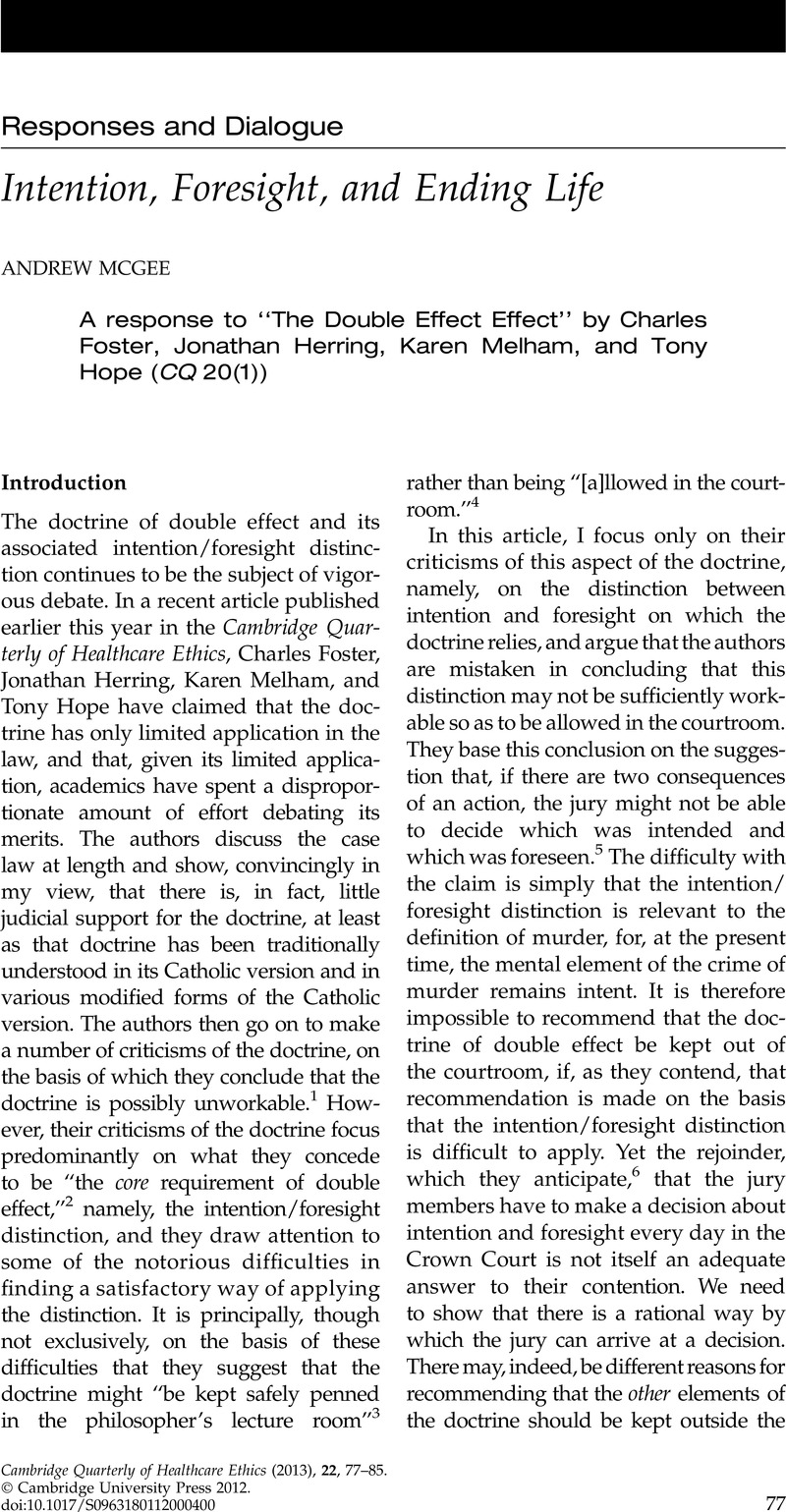Published online by Cambridge University Press: 04 December 2012

1. Foster, C, Herring, J, Melham, K, Hope, T. The double effect effect. Cambridge Quarterly of Healthcare Ethics 2011;20:56–72Google Scholar, at 69.
2. See note 1, Foster et al. 2011, 59 (italics added).
3. See note 1, Foster et al. 2011, 69.
4. See note 1, Foster et al. 2011, 69.
5. See note 1, Foster et al. 2011, 69.
6. See note 1, Foster et al. 2011, 69
7. See note 1, Foster et al. 2011, 69.
8. See note 1, Foster et al. 2011, 67.
9. See note 1, Foster et al. 2011, 67.
10. See note 1, Foster et al. 2011, 67. One might have argued that, in the headhunter case, killing is the means by which the headhunter adds to his collection. But the authors state that killing “is not necessarily a means to achieving the end of getting a head for a collection.” No reason is offered for this claim, and, for reasons we will see in the bomber example discussed subsequently, it is questionable that killing is not a means.
11. See note 1, Foster et al. 2011.
12. Harris, J. The Value of Life. Abingdon: Routledge; 1985Google Scholar, at 43–4.
13. See note 12, Harris 1985, 44.
14. Williams, G. Textbook of Criminal Law. 2nd ed.London: Stevens & Sons; 1983Google Scholar, at 85.
15. There are controversies about the nature of a means discussed by Nancy Davis (Davis, N. The problem of double effect. In: Woodward, PA, ed. The Doctrine of Double Effect. Notre Dame, IN: University of Notre Dame Press; 2001:119–42Google Scholar) that I cannot discuss here.
16. Goff, R. The mental element in the crime of murder. Law Quarterly Review 1988;104:30–59.Google Scholar
17. To be clear, we are speaking about foreseen deaths here, not deaths caused accidentally that aren’t in fact foreseen. The gravity of the foreseen consequence means it is intended.
18. Duff, A. The obscure intentions of the House of Lords. Criminal Law Review 1986;771–81:778–9.Google Scholar
19. Failure to notice that a difference of degree can become a difference in kind is the source of all the confusion that has been generated by this bomber example. Indeed, one might object that I have confused requirement 3 of the Catholic doctrine of double effect (that the consequence be foreseen, rather than intended) with requirement 4 (that there be a sufficiently serious reason for allowing the bad consequence). However, my argument is that the gravity of the bad consequence itself impinges on the issue of what is intended and what is foreseen, and so requirement 4 actually helps determine whether requirement 3 is satisfied.
20. This point was first made by Wittgenstein in The Blue and Brown Books. Oxford: Basil Blackwell; 1958.
21. Note that this point about the gravity of the consequence holds of consequences that are certain to ensue. The certainty of its ensuing, plus its gravity, gives rise to the transition from quantity to quality I have described. However, when it is not necessarily certain that the consequence will ensue, then whether or not the consequence is intended remains in that case an evidential issue. This is because, even if the consequence is grave, if it is possible that the course of conduct that led to it might not have given rise to that consequence, it may be credible in such a case for the agent to say that he or she did not intend the grave consequence that ensued.
22. See note 1, Foster et al. 2011, 69.
23. For further discussion of the differences between pain relief hastening death and withholding and withdrawing life-sustaining measures, on the one hand, and euthanasia, on the other, see McGee, A. Finding a way through the ethical and legal maze: Withdrawal of medical treatment and euthanasia. Medical Law Review 2005;357–85Google Scholar, and McGee, A. Defending the sanctity of life principle: A reply to John Keown. Journal of Law and Medicine 2011;18:820–34Google Scholar. The latter article also addresses another concern of the authors that I have no space to discuss here, namely, the question of how doctors can distinguish their own intent and their foresight. (See note 1, Foster et al. 2011, 69.)
24. If someone wanted to insist that death is at least the means by which the end is achieved, it should be stressed that in that case it is not the means to relieving pain, but rather to ending it, but for reasons we are about to see, thinking of death as the means of ending pain is arguably misleading, for it is the patient’s life that is ended.
25. Traditionally, the morality of the conduct has been seen to reside in whether the consequence is intended. But we have shown that in both cases, the consequence is intended. This does not mean, however, that there can’t be circumstances in which one case might be seen as more morally reprehensible than the other, in which, e.g., the death is intended just for the thrill of it. The point is that its moral reprehensibility does not reside solely in questions of intention but extends to issues of motive and so on.
26. In my view, the case of Re A [2000] 4 All ER 961 would apply, but I have no space to develop the point here.
27. See Bennett J. The Act Itself. Oxford: Oxford University Press; 1995:204ff.
28. I suspect that sometimes the reason it has been thought that double effect reasoning can apply to this case is that the baby may not have full personhood rights.
29. Re A [2000] 4 All ER 961.
30. These cases are discussed, among others, by Bennett. See note 27, Bennett 1995, 214ff.
31. See note 27, Bennett 1995, 214ff.
32. See note 1, Foster et al. 2011, 67.